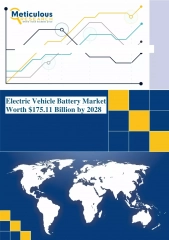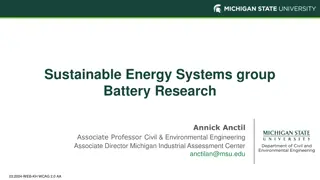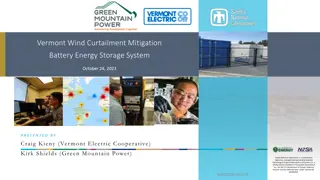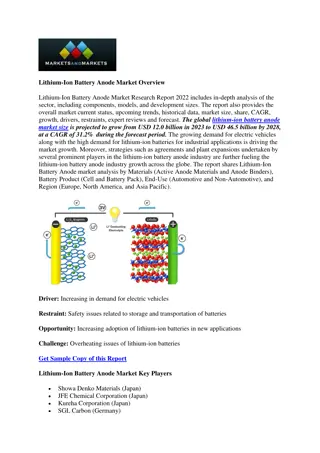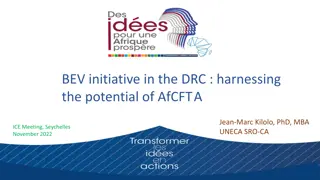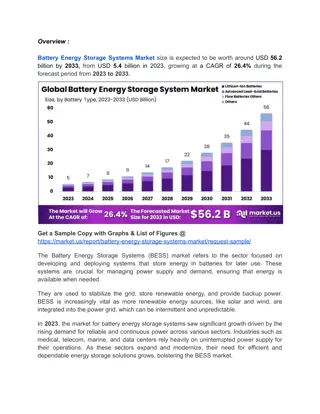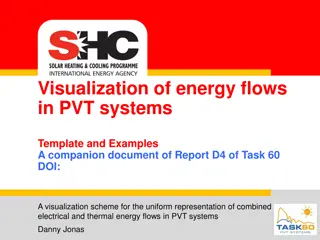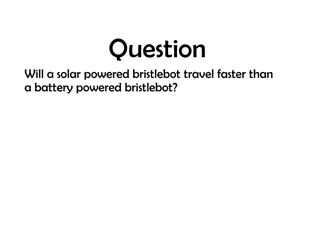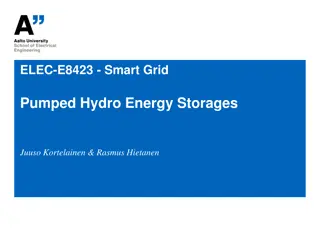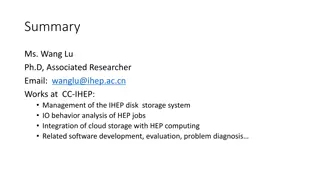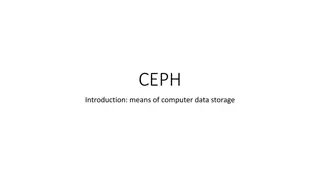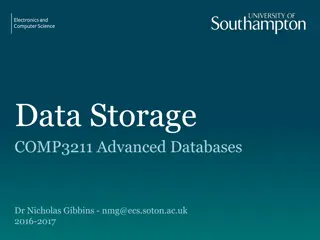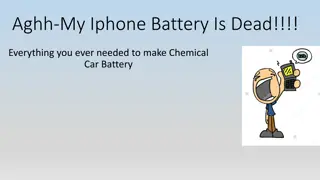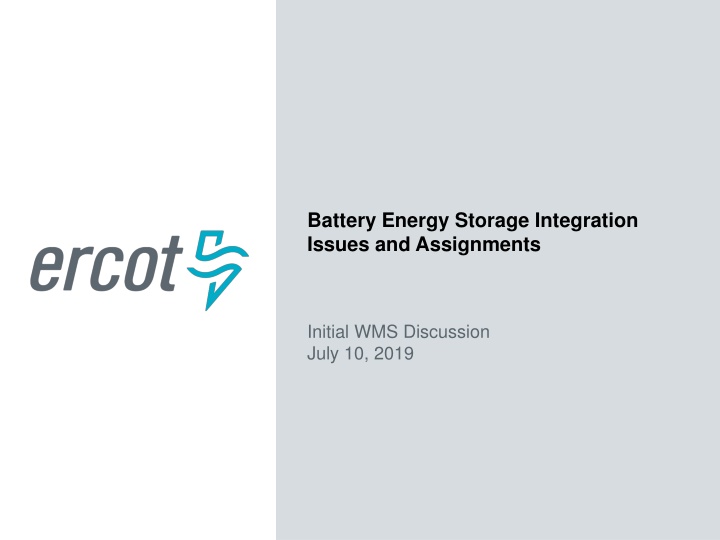
Battery Energy Storage Integration Issues
ERCOT stakeholders discussed issues related to Battery Energy Storage integration during a workshop. The workshop identified key problems and assigned action items to work groups for resolution. Specific issues addressed include Wholesale Storage Load Treatment, Market System Design Changes, and State of Charge/Limited Duration Considerations among others.
Uploaded on | 0 Views
Download Presentation

Please find below an Image/Link to download the presentation.
The content on the website is provided AS IS for your information and personal use only. It may not be sold, licensed, or shared on other websites without obtaining consent from the author. If you encounter any issues during the download, it is possible that the publisher has removed the file from their server.
You are allowed to download the files provided on this website for personal or commercial use, subject to the condition that they are used lawfully. All files are the property of their respective owners.
The content on the website is provided AS IS for your information and personal use only. It may not be sold, licensed, or shared on other websites without obtaining consent from the author.
E N D
Presentation Transcript
Battery Energy Storage Integration Issues and Assignments Initial WMS Discussion July 10, 2019
Background ERCOT stakeholders discussed issues associated with the integration of Battery Energy Storage during a workshop held on April 23, 2019. These issues were consolidated and summarized in a document which was presented along with potential working group assignments at the May 22 meeting of the Technical Advisory Committee (TAC). TAC endorsed the issues lists and proposed assignments. The next four slides, taken from the TAC presentation, indicate the issues assigned to WMS. 2 PUBLIC
Issue 3: Wholesale Storage Load Treatment Summary: Review process for approval of wholesale storage load (WSL) requests Assignment: Wholesale Market Subcommittee (WMS)/Metering Working Group Notes: - - - WSL requests for battery devices co-located with other resources WSL for batteries at Private Use Networks (PUNs) WSL for batteries connected to a DSP System (SODG with only aux load and SODG co-located with customer load) 3 PUBLIC
Issue 4: Market System Design Changes Summary: Review design and requirement changes that allow ERCOT to better model battery energy storage devices in its Market Management System (MMS) Assignment: WMS Notes: - Battery devices are currently modeled as two independent resources a generation device and a Controllable Load Resources. MMS revisions will be required to model a battery device as one device that can extract and generate electricity. Review device-specific assumptions and bidding requirements - 4 PUBLIC
Issue 6: State of Charge/Limited Duration Considerations Summary: Develop protocol revisions to account for consideration of state of charge of battery devices in day-ahead and real-time markets Assignment: WMS and ROS Notes: - Develop appropriate battery state of charge requirements/procedures for: - Reliability-Unit Commitment (RUC) - Day-Ahead Market awards - Real-time dispatch - ORDC and PRC - Energy Emergency Alert (EEA) Procedures - COPS submittals - Communication and Implementation of Operational Limitations - How to maximize value of battery energy devices to resource owners and to grid operations - Use of limited duration devices to resolve transmission constraints - Transmission planning study assumptions 5 PUBLIC
Issue 7: Alternate Device Modeling Options Summary: Assess potential alternate approaches to integrating coupled devices Assignment: WMS and ROS Notes: - - AC-coupled devices with jointly controlled operations or non-physical device limitations DC-coupled devices (multiple devices sharing inverters) 6 PUBLIC
The Path Forward ERCOT proposes to bring these issues to WMS for stakeholder discussion and possible assignment to working groups over the next few months. When stakeholder consensus is achieved, the issues will be brought back to WMS and TAC. When enough of these issues are resolved, ERCOT will incorporate these changes into a protocol revision request for further stakeholder review. New issues identified during stakeholder discussions can be added to the overall list. The order these issues are addressed is also subject to stakeholder review. ERCOT will develop a monthly summary of battery storage discussions at all the working groups and subcommittees and post this summary to the upcoming TAC meeting page. 7 PUBLIC
Initial Issues ERCOT proposes that WMS address how battery resource owners should indicate their operational preferences in the real-time market. 8 PUBLIC
Real-Time Dispatch NPRR 915 defined a Limited Duration Resource resource attribute as follows: A Generation Resource less than 10 MW or a Load Resource less than 10 MW that may be unavailable to Security-Constrained Economic Dispatch (SCED) due to the need to maintain its current state of charge. and added the following language to protocols section 3.8.5: (1) If the QSE for a Limited Duration Resource (LDR), operating as a Generation Resource, does not want SCED to send Base Points to deploy the LDR, then the QSE shall set the telemetered Resource Status to OFF. NPRR 915 was not intended to be a long-term solution, and it does not apply to all battery resources. 9 PUBLIC
Communicating Dispatch Preferences What are the ways that a battery storage resource QSE can indicate their dispatch preferences in the real-time market? Resource Status Resource Capability (HSL) Energy Offer Curve State of Charge Others Considerations for limited duration resources: Battery may be scheduled to provide energy or A/S in a future hour QSE may believe energy or A/S prices will be higher in a future period Telemetered data should not obscure actual capability of the device QSE preferences may change due to market conditions 10 PUBLIC
Appendix The following slides provide the list of issues assigned to other subcommittees 11 PUBLIC
Issue 1: Resource Definition Summary: Develop appropriate terminology for protocol definitions of registered and unregistered battery energy storage devices Assignment: Resource Definition Task Force (RTF) Notes: - - Prerequisite for establishing technology-specific requirements in protocols Stakeholders have reviewed a proposed delineation of battery energy storage at RTF. 12 PUBLIC
Issue 2: Battery Energy Storage Operational Requirements Summary: Establish technology-specific operational requirements for battery storage devices as part of an effort encompassing a review of all inverter-based resources Assignment: Reliability and Operations Subcommittee (ROS) Notes: - Technology-specific requirements will be needed when new resource definitions are implemented Operational requirements will need to be specified for the devices when they are charging, discharging, and in transition Specific topics: Voltage support and coordination Voltage/frequency ride through Frequency Support Dynamic model submittal requirements Measurement and monitoring Dynamic performance requirements A/S performance requirements and limitations A/S Testing requirements Repowering considerations for interconnection studies - - 13 PUBLIC
Issue 5: Operations System Design Changes Summary: Review design and requirement changes that allow ERCOT to better model battery energy storage devices in its Energy Management System (EMS) Assignment: ROS Notes: - Battery devices are currently modeled as two independent resources a generation device and a Controllable Load Resources. EMS revisions (consistent with revisions made to MMS) will be required to model a battery device as one device that can extract and generate electricity. Review modeling requirements for downstream models used for operations reliability studies Revisions to Resource Integration and Ongoing Operations (RIOO) system and Network Model Management Systems (NMMS) Develop procedures for incorporating battery energy storage devices in operations and transmission planning studies and models - - - 14 PUBLIC
Issue 6: State of Charge/Limited Duration Considerations Summary: Develop protocol revisions to account for consideration of state of charge of battery devices in day-ahead and real-time markets Assignment: WMS and ROS Notes: - Develop appropriate battery state of charge requirements/procedures for: - Reliability-Unit Commitment (RUC) - Day-Ahead Market awards - Real-time dispatch - ORDC and PRC - Energy Emergency Alert (EEA) Procedures - COPS submittals - Communication and Implementation of Operational Limitations - How to maximize value of battery energy devices to resource owners and to grid operations - Use of limited duration devices to resolve transmission constraints - Transmission planning study assumptions 15 PUBLIC



